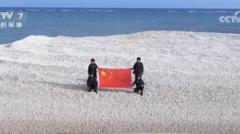In a significant move adding to the ongoing territorial disputes in the South China Sea, the Chinese coastguard has taken control of a small sandbank identified as Sandy Cay, according to reports from Chinese state media. Photographs aired by the state broadcaster CCTV depicted coastguard officers on the disputed reef, dressed in black and carrying the Chinese flag, asserting China's "sovereign jurisdiction" over the area.
This provocative maneuver comes amid rising tensions between China and the Philippines, with both nations having made competing claims over various islands and maritime zones in the region. The Philippine government has not yet issued an official response. Previously, confrontations between vessels of the two nations have led to physical scuffles and even collisions at sea.
Sandy Cay lies in proximity to a Philippine military outpost located on Thitu Island, which Manila utilizes to monitor Chinese activities in the area. Although recent reports confirm that the coastguard has since vacated the 200-square meter sandbank, the absence of permanent occupation by China raises alarms among global observers.
The White House has expressed deep concerns regarding China's actions on the reef. National Security Council spokesperson James Hewitt stated that such actions could destabilize the region and violate established international law.
This Chinese operation coincides with ongoing military exercises between US and Philippine forces, known as the Balikatan exercises, intended to enhance defense cooperation. Nearly 17,000 personnel are participating in the drills, which have attracted criticism from Beijing, citing them as provocative.
US Defense Secretary Pete Hegseth assured that the United States is reaffirming its commitment to the Philippines in the face of increasing Chinese assertiveness. Amid a historical backdrop of territorial disputes in the South China Sea, tensions have notably escalated in recent years, with China asserting its claims through expansive territorial strategies, including island-building and naval patrols, underpinned by its controversial "nine-dash line." Competing nations like Vietnam, Taiwan, Malaysia, and Brunei are also embroiled in the complex territorial disputes in this resource-rich sea.
This provocative maneuver comes amid rising tensions between China and the Philippines, with both nations having made competing claims over various islands and maritime zones in the region. The Philippine government has not yet issued an official response. Previously, confrontations between vessels of the two nations have led to physical scuffles and even collisions at sea.
Sandy Cay lies in proximity to a Philippine military outpost located on Thitu Island, which Manila utilizes to monitor Chinese activities in the area. Although recent reports confirm that the coastguard has since vacated the 200-square meter sandbank, the absence of permanent occupation by China raises alarms among global observers.
The White House has expressed deep concerns regarding China's actions on the reef. National Security Council spokesperson James Hewitt stated that such actions could destabilize the region and violate established international law.
This Chinese operation coincides with ongoing military exercises between US and Philippine forces, known as the Balikatan exercises, intended to enhance defense cooperation. Nearly 17,000 personnel are participating in the drills, which have attracted criticism from Beijing, citing them as provocative.
US Defense Secretary Pete Hegseth assured that the United States is reaffirming its commitment to the Philippines in the face of increasing Chinese assertiveness. Amid a historical backdrop of territorial disputes in the South China Sea, tensions have notably escalated in recent years, with China asserting its claims through expansive territorial strategies, including island-building and naval patrols, underpinned by its controversial "nine-dash line." Competing nations like Vietnam, Taiwan, Malaysia, and Brunei are also embroiled in the complex territorial disputes in this resource-rich sea.




















